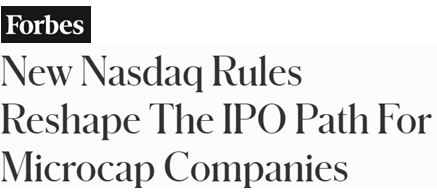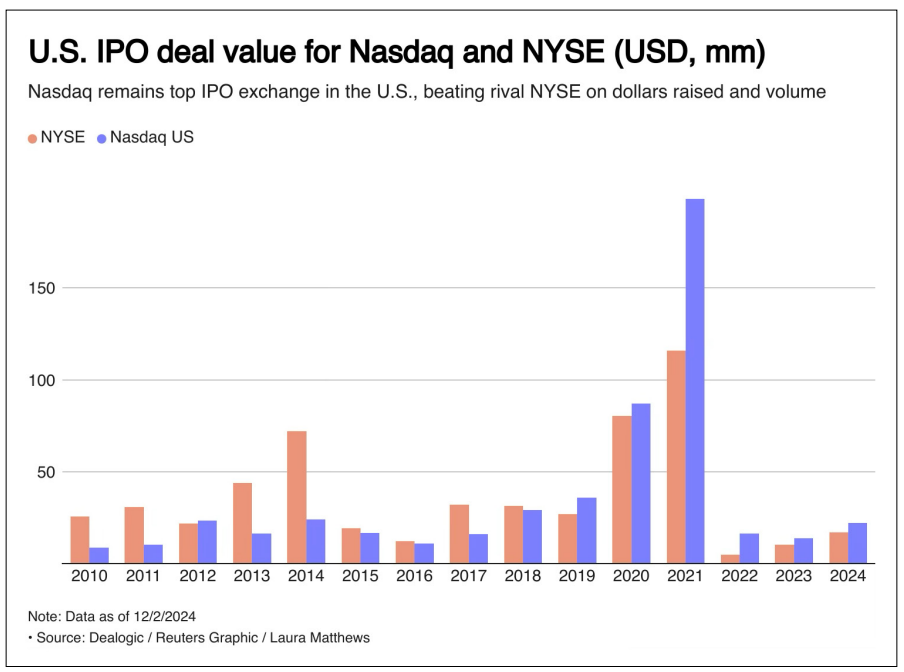 |
| By Chris Graebe |
When it comes to the world of private equity, an Initial Public Offering (IPO) is the finish line for many investors.
Not only does a public listing open the doors to new capital and increased visibility for the startup …
It allows investors the chance to target even greater returns.
But the goalpost — at least when it comes to the Nasdaq — has just been moved.
And it’s shaking up both the public and private markets.
The Nasdaq recently announced that, as of April 15, 2025, hopeful startups looking to list on the tech-heavy exchange need to be more liquid.

Whether a company is uplisting from the Over-the-Counter market or making its public-market debut, it must now raise at least $15 million in its Nasdaq IPO.
Part of that liquidity is the ability to show that the startup had at least $750,000 in audited net income in the previous fiscal year OR in two out of the past three fiscal years.
In other words, these potential microcaps have to show even more might than before.
Let’s zero in on that $15 million for a moment.
That’s a big jump from the previous rules. Before this change, startups only needed to show a raise of $5 million to enter.
Going further, the permitted sources of this funding have been redefined. This makes the new $15 million minimum even trickier to reach.
This shift is shaking up both the public and private markets.
But more importantly, this will undoubtedly impact investors like you.
As such, anyone interested in the high-growth companies that Nasdaq attracts — and the wider public sector in general — will benefit from knowing the details behind this groundbreaking change.
Here’s What’s Changed
The Nasdaq’s new $15 million listing minimum refers specifically to what’s called the Minimum Market Value of Unrestricted Publicly Held Shares, or MVUPHS.
The MVUPHS is the total dollar value of a company’s shares that are freely tradable by the public.
Before listing, this figure is calculated by the startup and its underwriter — usually an investment bank — based on several factors.
But this mainly gets derived from prospective investor interest.
The startup and underwriter determine a share price and the number of shares that will be offered in the IPO.
You may already be familiar with this metric: It’s the industry‑standard way to measure a company’s free float.
While the MVUPHS isn’t new, how Nasdaq now calculates it is.
The new requirements mean that, if the startup gets sold, the value of those shares must exceed $15 million.
If Nasdaq approves this plan, known as the preliminary prospectus, then plans for the real IPO can begin.
By raising the MVUPHS, Nasdaq hopes to limit the low-quality deals that have plagued the exchange recently.
This move aims to renew investor trust in IPOs.
Not by increasing their volume, but rather by increasing their quality.

Because it’s not just the minimum value that has changed.
Before April 11, companies could include in this figure not only the new shares sold in their IPO but also previously issued shares that were freely tradeable, such as those from old private placements that had their restrictions lifted.
But under the new rule, the standards have been raised.
Only the shares sold in the current offering will count toward that total.
This limitation isn’t insignificant.
The legacy shares that startups used to be able to include could often account for millions of dollars … and could be the sole reason they could even consider going public.
In short, the Nasdaq now demands that startups prove they are backed fully by real, present-day investor demand.
After all, these startups are looking to join the ranks of some of the most actively traded companies on the planet.
So, it’s not surprising that the premier destination for startup IPOs is asking these companies to become more game-day-ready.
For startups, the Nasdaq’s message is clear: Come with real capital, or don't come at all.
From a market quality perspective, it’s a win.
Happy hunting!
Chris Graebe
P.S. While quality in the IPO market is set to increase with this new rule, my readers should be relatively unaffected. We already strive for quality in our selections.
Part of the reason I’m so confident is all the data and analysis done by the wonderful Weiss Ratings team of researchers. Here’s how you can get access to what they are looking at every day.
P.P.S. And if you want to be on the list for the next official pre-IPO deal my readers will get, you’ll need to call our wonderful team and ask for Deal Hunters Alliance. You can reach them at 855.278.9191 or +1.561.627.3300 from overseas, Mon-Fri, 9:00-5:30 Eastern.
That deal could be revealed soon. So, time is limited.

